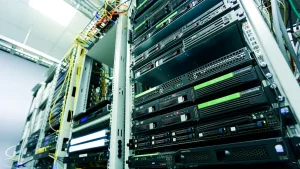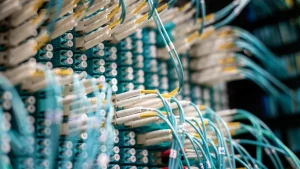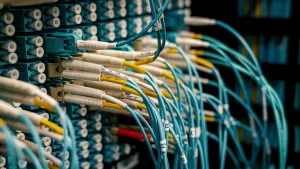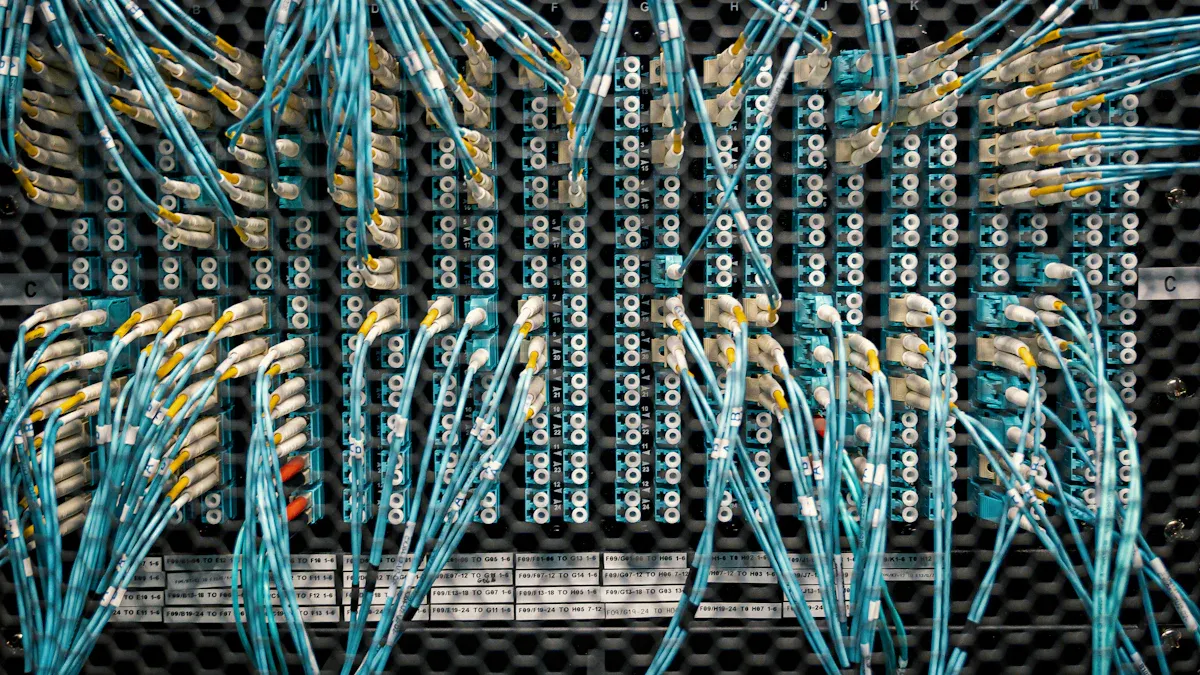
Selecting the right high-density fiber cable determines network success. MPO MTP Harness cables suit environments demanding rapid deployment and organized patching. Network architects see high-density fiber optics as essential for modern performance:
- These cables deliver higher bandwidth than copper.
- Light signals in fiber reduce latency and ensure reliability.
- Fiber supports scalable upgrades and resists interference.
- New technologies like WDM and SDM drive efficiency.
Proper cable selection ensures networks remain efficient and ready for future growth.
Key Takeaways
- MPO MTP Harness cables break out high-density trunks into individual connections, enabling fast, organized patching and flexible device aggregation.
- Trunk cables connect equipment directly over long distances, supporting high-speed backbone links with fewer cables and lower costs.
- Breakout and fanout cables split high-speed ports into multiple lower-speed connections, maximizing port use and easing network upgrades.
- Choosing the right cable type depends on network needs like distance, speed, flexibility, and future growth to ensure reliable and scalable performance.
- Proper installation and regular maintenance, including careful handling and cleaning of connectors, prevent damage and signal loss.
- Though harness and breakout cables may cost more initially, their modularity and ease of upgrades save time and money long term.
- Future-proof networks by using modular designs, single-mode fiber, multiplexing, and detailed documentation to support growth and technology changes.
- Avoid common mistakes by respecting bend radius, verifying polarity, and using trained personnel to maintain high network reliability.
MPO MTP Harness and High-Density Fiber Cable Types
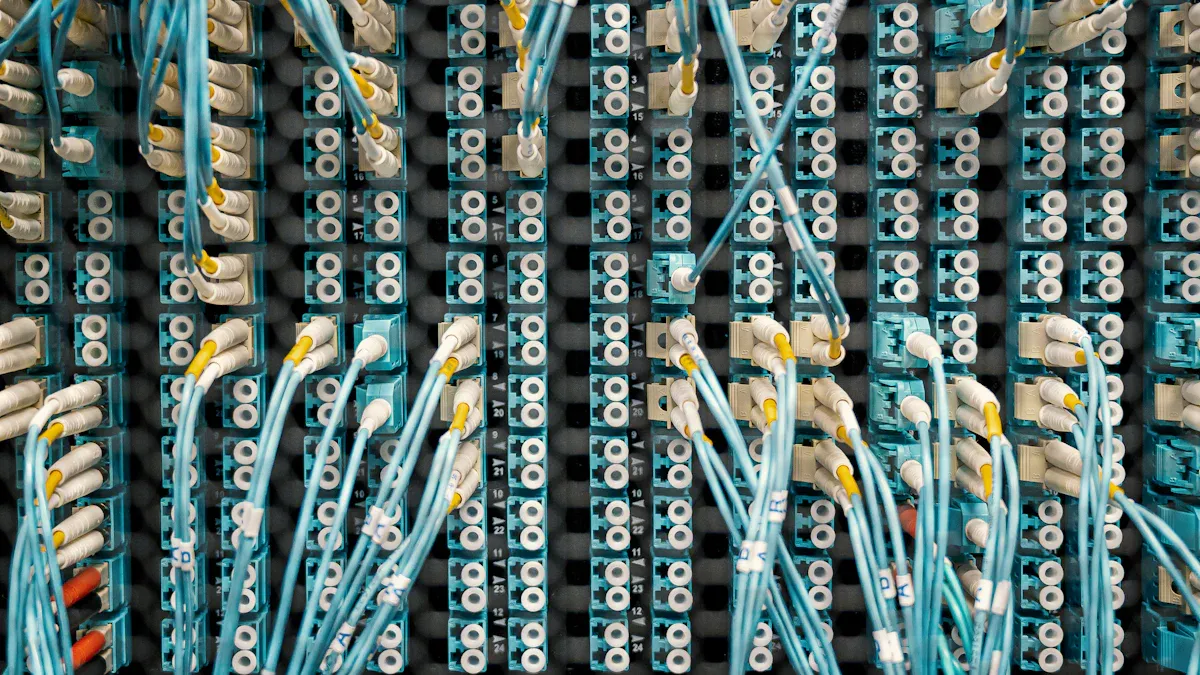
MPO MTP Harness Cables
Definition
MPO MTP Harness cables feature a multi-fiber MPO or MTP connector on one end and multiple discrete connectors, such as LC or SC, on the other. This design enables the cable to break out a high-density fiber trunk into individual connections. The harness structure supports organized patching and simplifies the process of connecting high-speed backbone links to legacy equipment.
Typical Applications
Network engineers deploy MPO MTP Harness cables in environments that require rapid installation and efficient cable management. These cables often appear in data centers, where they connect backbone trunks to patch panels or switches. Technicians use harness cables to facilitate modular patching, streamline upgrades, and maintain order in high-density racks. The harness configuration proves valuable for server-to-switch aggregation and modular deployments, supporting both scalability and flexibility.
MPO/MTP Trunk Cables
Definition
MPO/MTP trunk cables consist of multi-core optical fibers terminated with MPO or MTP connectors on both ends. Each end maintains the same fiber count, which allows for parallel transmission of high-bandwidth signals. The trunk cable structure supports direct connections between equipment or distribution frames, reducing the need for multiple individual cables.
The following table highlights the structural and application differences between MPO/MTP trunk cables and other high-density fiber cable types:
| Aspect | MPO/MTP Trunk Cables | Other High-Density Fiber Cable Types (e.g., Breakout Cables) |
|---|---|---|
| Connector Type (Side A) | MPO/MTP fiber connector | MPO/MTP fiber connector |
| Connector Type (Side B) | MPO/MTP fiber connector | Multiple duplex connectors (LC/SC) |
| Fiber Count | Same multi-fiber count on both ends | Multi-fiber on one end, breakout into multiple duplex fibers on the other end |
| Fiber Type | Multimode (OM3/OM4/OM5) or Singlemode (OS2) | Multimode (OM3/OM4/OM5) or Singlemode (OS2) |
| Typical Applications | High-speed backbone direct connections (40G, 100G, 400G, 800G) | Device breakout connectivity (e.g., 4x10G, 4x25G, 4x50G, 4x100G, 8x100G) |
| Main Purpose | Direct trunk connections between equipment or distribution frames | Splitting high-speed ports into multiple lower-speed ports for flexible device connectivity |
Typical Applications
MPO/MTP trunk cables serve as the backbone for high-speed data transmission in data centers, enterprise networks, and telecom infrastructures. Engineers use trunk cables to connect switches, routers, and distribution frames directly, supporting speeds from 40G to 800G. The trunk design simplifies cabling, saves space, and supports both long-distance single-mode and short-distance multi-mode deployments.
MPO/MTP Breakout Cables
Definition
MPO/MTP breakout cables convert a single high-density MPO or MTP connector into multiple discrete duplex connectors, such as LC or SC. This configuration enables the cable to split high-bandwidth signals into several lower-speed channels, supporting flexible device connectivity and efficient cable management.
Typical Applications
- MPO/MTP breakout cables function as fiber distribution units, converting a single high-density connector into multiple discrete duplex connectors.
- Technicians use breakout cables to interface backbone MTP ports with legacy equipment, such as 10G SFP+ switches and SAN storage arrays.
- Breakout cables are ideal for top-of-rack deployments in data centers, connecting switches, routers, and servers.
- These cables support high-density, scalable, and modular network infrastructures, facilitating efficient cable management and rapid deployment.
Network architects rely on breakout cables to enable transitions between different network speeds and to support modularity in cloud computing and virtualization environments. The breakout design proves essential for rapid deployment and easy scaling in modern data centers.
MPO/MTP Fanout Cables
Definition
MPO/MTP fanout cables, sometimes called breakout cables, feature a single high-density MPO or MTP connector on one end and multiple discrete connectors—such as LC or SC—on the other. This design allows a single multi-fiber trunk to split into several individual fiber channels. Each channel can connect directly to devices or ports that require lower-speed duplex connections. The fanout structure supports parallel optical transmission, which is essential for high-bandwidth applications that demand large data throughput and low latency.
Manufacturers design these cables to simplify the transition between high-density backbone infrastructure and equipment with standard duplex ports. The fanout configuration reduces the need for multiple patch cords and minimizes cable congestion in racks. By consolidating several connections into a single assembly, fanout cables help maintain organized and efficient cabling systems.
Typical Applications
Network engineers rely on MPO/MTP fanout cables in high-density environments where flexibility and scalability are critical. These cables play a vital role in data centers, enterprise networks, and cloud computing facilities. They enable the connection of high-speed backbone links to multiple lower-speed devices, such as servers, switches, or storage arrays.
MPO/MTP fanout cables increase network flexibility by allowing multiple lower-speed connections to be derived from a single high-speed MPO/MTP port. This capability supports scalable and flexible network configurations, which is essential for high-density environments. The design of fanout cables reduces cabling complexity, improves airflow by minimizing cable congestion, and facilitates smooth transitions during network upgrades or reconfigurations.
A typical deployment might involve connecting a 40G or 100G switch port to four or eight 10G or 25G server ports. This approach maximizes port utilization and supports efficient expansion as network demands grow. Fanout cables also prove valuable during network upgrades, enabling seamless transitions from legacy systems to modern high-speed infrastructure.
The following table highlights the key differences between MPO/MTP trunk cables and MPO/MTP fanout cables:
| Aspect | MPO/MTP Trunk Cables | MPO/MTP Breakout (Fanout) Cables |
|---|---|---|
| Connector Type (One End) | MPO/MTP connector | MPO/MTP connector |
| Connector Type (Other End) | MPO/MTP connector | Multiple duplex LC or SC connectors |
| Fiber Count | Same multi-fiber count on both ends | Multi-fiber on one end, split into duplex fibers on the other |
| Typical Applications | Backbone direct connections (40G, 100G, 400G, 800G) | Splitting high-speed ports into multiple lower-speed ports (e.g., 4x10G, 4x25G) |
| Main Purpose | Direct equipment or distribution frame connections | High-density port breakout, flexible connection to multiple devices |
Network architects choose fanout cables to simplify cabling, improve port utilization, and support efficient deployment in modern data centers. The fanout design ensures that networks remain adaptable, organized, and ready for future growth.
Key Differences Among MPO MTP Harness, Trunk, Breakout, and Fanout Cables
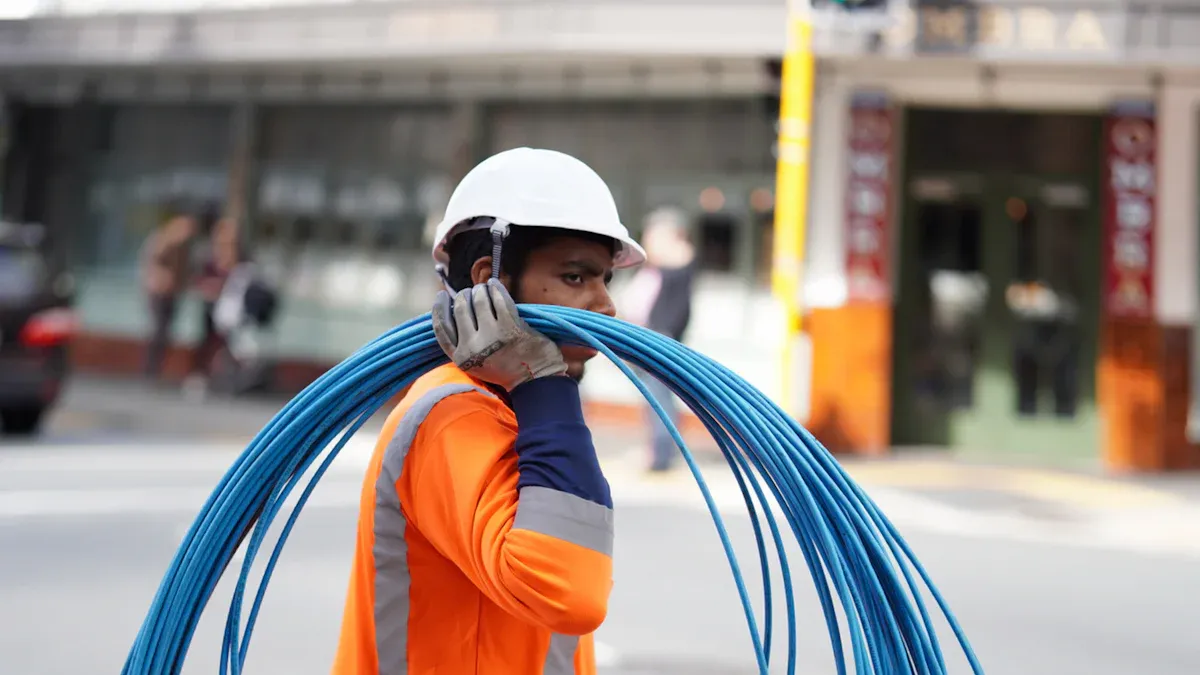
Structure and Design
Manufacturers design each high-density fiber cable type with distinct structural features to address specific network requirements. MPO/MTP trunk cables contain multiple optical fibers bundled together, terminated with MPO/MTP connectors at both ends. This structure supports long-distance backbone cabling and minimizes the need for intermediate patching.
MPO MTP Harness cables, also known as breakout or fanout cables, feature a multi-fiber MPO connector on one end. The opposite end splits into individual fibers, each terminated with connectors such as LC, SC, or ST. Protective jacketing surrounds the breakout section, ensuring durability and organized routing. This design enables direct device connections and reduces reliance on patch panels.
Conversion cables offer a fanout structure similar to harness cables but terminate with MPO/MTP connectors on both ends. The fiber count and type may differ at each end, optimizing existing cabling systems and increasing network capacity.
Network engineers select cable structures based on deployment distance, density, and the need for direct device connectivity. Harness and fanout cables simplify short-range connections, while trunk cables excel in backbone applications.
The following table summarizes the structural differences:
| Cable Type | Structure Description | Fiber Count Range | Connector Types at Ends | Typical Use Case / Application |
|---|---|---|---|---|
| MPO/MTP Trunk Cable | Multi-fiber cable with MPO/MTP connectors at both ends; no fiber breakout; designed for longer runs. | 12, 24, 48, 72 fibers | MPO/MTP connectors on both ends | High-density, long-distance backbone cabling |
| MPO/MTP Harness Cable (Breakout/Fanout) | Multi-fiber MPO connector on one end splits into individual fibers terminated with LC, SC, or ST connectors; includes protective jacketing. | 8 to 144 individual fibers | MPO connector on one end; LC/SC/ST on other end | Short-range connections directly to devices; reduces need for patch panels and extra equipment |
| MPO/MTP Conversion Cable | Fanout design similar to harness cables but terminated with MPO/MTP connectors on both ends; fiber counts/types differ at each end. | Varies (e.g., 12 to 24 fibers) | MPO/MTP connectors on both ends | Optimizes existing cabling systems by matching different fiber counts; increases network capacity |
Connector Types and Compatibility
Connector types and gender play a critical role in ensuring reliable network performance and compatibility with equipment. MPO/MTP trunk cables typically use male-to-male MPO connectors, designed for backbone cabling. Patch cables feature female-to-female MPO connectors, which connect equipment ports to trunk cables and maintain low insertion loss.
MPO MTP Harness cables support a wide range of single-fiber connectors, including LC, SC, FC, ST, and MTRJ. The MPO connector on one end can be male or female, while the fanout end uses generic connectors to interface with devices. This flexibility allows seamless transitions from high-density trunks to equipment with single-fiber ports.
Proper mating of MPO connectors is essential. Male connectors have guide pins, while female connectors have holes. One male and one female connector must mate to avoid high loss or physical damage. Network equipment such as transceivers and cassettes usually feature male MPO ports with built-in sleeve adapters. Standard cabling practices use female-to-female patch cables to connect to equipment, ensuring alignment and optimal performance.
Compatibility depends on matching connector gender and type. Incorrect mating can result in signal loss or equipment damage. Standardization of connector types ensures reliable connections and simplifies installation.
The table below outlines connector types and compatibility:
| Cable Type | Connector Gender Type | Connector Types Supported | Compatibility Impact |
|---|---|---|---|
| Harness Cables | MPO (male or female) + fanout to single-fiber connectors (LC, SC, FC, ST, MTRJ, etc.) | MPO on one end, generic single-fiber connectors on the other | Allows transition from MPO trunk to equipment with single-fiber ports; supports simplex and duplex connections |
| Trunk Cables | Male-to-Male MPO | MPO connectors only | Designed for backbone cabling; mates with female MPO connectors on patch cables or equipment |
| Patch Cables | Female-to-Female MPO | MPO connectors only | Connects equipment (male MPO ports) to trunk cables; ensures proper mating and low insertion loss |
| Extender Cables | Male-to-Female MPO | MPO connectors only | Used to extend cable runs; must match connector genders to avoid damage and maintain performance |
Scalability and Flexibility
Scalability and flexibility define the long-term value of high-density fiber cabling. MPO/MTP trunk cables provide a scalable backbone for large networks. Their multi-fiber design supports rapid upgrades to higher bandwidths without extensive rewiring. Trunk cables excel in environments where future expansion is a priority.
MPO MTP Harness cables offer unmatched flexibility for short-range connections. Their fanout structure enables direct device connectivity, reducing the need for patch panels and extra equipment. Engineers can quickly adapt harness cables to changing network layouts, supporting modular deployments and rapid upgrades.
Breakout and fanout cables further enhance flexibility by allowing high-speed ports to split into multiple lower-speed channels. This capability maximizes port utilization and simplifies transitions between legacy and modern equipment. Network architects use these cables to support scalable, high-density environments and to facilitate smooth upgrades.
Choosing the right cable type ensures networks remain adaptable and ready for future growth. Harness and fanout cables support modularity, while trunk cables provide robust backbone scalability.
- Trunk cables: Ideal for backbone scalability and long-distance runs.
- Harness cables: Best for flexible, direct device connections.
- Breakout/fanout cables: Enable modular expansion and efficient port utilization.
Installation and Maintenance
Proper installation and maintenance play a crucial role in the performance and longevity of high-density fiber cabling systems. Each cable type presents unique challenges and requirements during deployment and upkeep.
MPO/MTP Trunk Cables
Technicians often prefer trunk cables for backbone connections due to their straightforward installation. These cables feature identical connectors on both ends, which simplifies routing between distribution frames or switches. Trunk cables reduce cable clutter and minimize the risk of miswiring. However, installers must pay close attention to polarity and connector gender to ensure proper signal transmission.
MPO MTP Harness Cables
Harness cables require careful handling during installation. The fanout section contains multiple delicate fibers, each with its own connector. Installers must avoid excessive bending or pulling to prevent fiber breakage. Labeling each connector helps reduce confusion during patching and future maintenance. Harness cables excel in modular environments, where rapid changes and upgrades occur frequently.
Breakout and Fanout Cables
Breakout and fanout cables share similar installation practices with harness cables. The main challenge involves managing the split ends and ensuring each connector reaches its intended port. Technicians often use cable management accessories, such as trays or clips, to organize the fanout section. Regular inspection and cleaning of connectors help maintain optimal performance.
Tip: Always use proper cleaning tools and follow manufacturer guidelines when handling MPO/MTP connectors. Dirty or damaged connectors can cause significant signal loss and network downtime.
Maintenance Best Practices
- Inspect connectors regularly for dust or damage.
- Use visual fault locators to identify breaks or faults.
- Replace damaged cables promptly to avoid network disruptions.
- Document cable routes and connections for easier troubleshooting.
| Cable Type | Installation Complexity | Maintenance Frequency | Key Considerations |
|---|---|---|---|
| Trunk | Low | Low | Polarity, connector gender |
| Harness | Medium | Medium | Fanout management, labeling |
| Breakout/Fanout | Medium | Medium | Split-end organization, cleaning |
A well-planned installation and regular maintenance schedule ensure reliable network operation and reduce the risk of costly outages.
Cost Considerations
Cost remains a significant factor when selecting high-density fiber cables. Each cable type carries its own price structure, influenced by materials, labor, and long-term scalability.
MPO/MTP Trunk Cables
Trunk cables often provide the most cost-effective solution for large-scale backbone deployments. Their multi-fiber design reduces the number of individual cables required, lowering both material and labor costs. Bulk installation further decreases expenses, especially in new data center builds.
MPO MTP Harness Cables
Harness cables typically cost more per unit than trunk cables due to their complex construction and multiple connectors. However, they can reduce overall costs in environments that require frequent reconfiguration or direct device connections. The ability to connect multiple devices with a single assembly saves time and minimizes the need for additional patch panels.
Breakout and Fanout Cables
Breakout and fanout cables fall in a similar price range as harness cables. Their value increases in scenarios where network flexibility and rapid expansion are priorities. These cables help avoid the expense of purchasing extra transceivers or patch cords.
Note: While initial costs may seem higher for harness, breakout, or fanout cables, their modularity and ease of upgrade can lead to long-term savings by reducing downtime and labor during network changes.
Cost Comparison Table
| Cable Type | Initial Material Cost | Installation Labor Cost | Long-Term Savings Potential | Typical Use Case |
|---|---|---|---|---|
| Trunk | Low | Low | High | Backbone cabling |
| Harness | Medium | Medium | Medium | Modular, device-level connections |
| Breakout/Fanout | Medium | Medium | High | Flexible, scalable deployments |
Network planners should evaluate both upfront and ongoing costs. Investing in the right cable type can optimize budget allocation and support future network growth without unexpected expenses.
Side-by-Side Comparison Table
Comparison Criteria Overview
Network engineers evaluate high-density fiber cables using several technical and performance criteria. These criteria help determine the best cable type for specific network scenarios. The most common comparison points include supported fiber types, polishing and polarity options, fiber counts, and channel configurations. Engineers also consider insertion loss, skew performance, and standards compatibility. Cable assembly types—such as harness, trunk, breakout, and fanout—differ in fiber counts, connector types, and intended applications.
Recent technical discussions highlight additional metrics. Speed and supported transmission distance play a major role in cable selection. Multimode fiber, such as OM4 and OM5, supports high speeds but has distance limitations compared to singlemode fiber. Cable diameter affects rack density and airflow, while cost includes both initial investment and long-term upgrade expenses. Newer multimode technologies offer advanced multiplexing but may require specialized pluggables, increasing overall costs. Singlemode fiber provides greater flexibility for future-proofing, with narrowing cost differences in transceivers.
Choosing the right cable type depends on balancing technical specifications, performance metrics, and cost considerations. This approach ensures reliable, scalable, and efficient network deployments.
Table: MPO MTP Harness vs Trunk vs Breakout vs Fanout
The following table presents a side-by-side comparison of MPO MTP Harness, trunk, breakout, and fanout cables. It summarizes key criteria to help network architects select the optimal solution for their environment.
| Criteria | MPO MTP Harness | Trunk Cable | Breakout Cable | Fanout Cable |
|---|---|---|---|---|
| Supported Fiber Types | G 652D, G 657A, OM2, OM3, OM4 | G 652D, G 657A, OM2, OM3, OM4 | G 652D, G 657A, OM2, OM3, OM4 | G 652D, G 657A, OM2, OM3, OM4 |
| Polishing Types | PC, UPC, APC | PC, UPC, APC | PC, UPC, APC | PC, UPC, APC |
| Polarity Types | Type A, Type B | Type A, Type B | Type A, Type B | Type A, Type B |
| Fiber Counts | 8, 12, 24, up to 144 | 12, 24, 48, 72 | 8, 12, 24 | 8, 12, 24 |
| Channel Configurations | 4 Tx/4 Rx, 10 Tx/10 Rx | 4 Tx/4 Rx, 10 Tx/10 Rx | 4x10G, 4x25G, 4x100G | 4x10G, 4x25G, 4x100G |
| Insertion Loss | Standard, low loss | Standard, low loss | Standard, low loss | Standard, low loss |
| Skew Performance | IEEE 802.3ba, InfiniBand | IEEE 802.3ba, InfiniBand | IEEE 802.3ba, InfiniBand | IEEE 802.3ba, InfiniBand |
| Standards Compatibility | IEEE 802.3ba, QSFP+ SR4, CFP+ SR10 | IEEE 802.3ba, QSFP+ SR4, CFP+ SR10 | IEEE 802.3ba, QSFP+ SR4, CFP+ SR10 | IEEE 802.3ba, QSFP+ SR4, CFP+ SR10 |
| Cable Diameter | Medium | Small to medium | Medium | Medium |
| Speed & Distance | High speed, short to medium | Highest speed, long distance | High speed, short distance | High speed, short distance |
| Cost Considerations | Medium | Low | Medium | Medium |
| Typical Applications | Modular patching, device aggregation | Backbone cabling, switch-to-switch | Legacy device breakout, top-of-rack | Flexible port breakout, scalable deployments |
- MPO MTP Harness cables provide organized patching and direct device connections.
- Trunk cables excel in backbone applications, supporting long-distance, high-speed links.
- Breakout and fanout cables enable flexible port utilization and modular expansion.
Network planners should review these criteria to match cable types with deployment needs, ensuring optimal performance and cost efficiency.
Choosing the Right High-Density Fiber Cable
Assessing Network Requirements
Selecting the optimal high-density fiber cable begins with a thorough assessment of network requirements. Each environment presents unique challenges and demands. Network planners must evaluate several critical factors before making a decision:
- Environmental conditions: Determine if the installation will occur indoors or outdoors. Indoor cables often use PVC jackets, while outdoor deployments require PE jackets for weather resistance.
- Mechanical properties: Assess abrasion resistance and flexibility. Cables must withstand physical wear and installation stress.
- Chemical resistance: Choose jacket materials that resist chemicals, oils, or solvents when exposure is likely.
- Temperature range: Ensure cables maintain flexibility in low temperatures and resist deformation in high temperatures.
- Fire safety ratings: Select jackets with flame-retardant properties, such as PVC for fire resistance or LSZH for low smoke and toxicity.
- Fiber count: Match the number of fiber strands to current needs and anticipated future growth.
- Cable flexibility: Prioritize flexibility for installations with frequent bending or movement.
- Performance factors: Consider bandwidth requirements, signal integrity, and connector compatibility for optimal operation.
Data Center Environments
Data centers demand high-density, scalable, and reliable cabling. Engineers often select MPO/MTP trunk cables for backbone connections due to their ability to support high bandwidth and long-distance runs. Harness and fanout cables provide flexibility for connecting servers, switches, and storage devices within racks. Environmental controls in data centers allow the use of cables with standard fire ratings and moderate mechanical protection.
Enterprise Networks
Enterprise networks require a balance between scalability and manageability. Modular patching and frequent reconfiguration are common. MPO/MTP harness cables enable rapid deployment and organized patching, especially in wiring closets and equipment rooms. Network planners often choose cables with enhanced flexibility and abrasion resistance to accommodate moves, adds, and changes.
Campus and Building Backbones
Campus and building backbones span longer distances and may traverse diverse environments. Outdoor-rated cables with robust jackets and high fiber counts ensure reliable connectivity between buildings. Fire safety and chemical resistance become critical in shared conduits or plenum spaces. Trunk cables often serve as the backbone, while fanout or breakout cables provide device-level connections at endpoints.
Practical Examples and Use Cases
Network architects benefit from real-world examples when selecting high-density fiber cables. The following table highlights practical deployment scenarios for MPO/MTP harness cables across various environments:
| Deployment Scenario | Practical Example Description |
|---|---|
| Enterprise/Campus Networks | UHD system modules installed using plug and play or pre-terminated MTP/MPO modules, enabling fast, easy installation without requiring professional fiber optics knowledge. |
| Data Center SAN | MTP/MPO plug and play modules widely used for high-density backbone connections, supporting hundreds of optical ports and easy reconfiguration. |
| Data Center Co-Location | Pre-terminated UHD MTP/MPO systems enable rapid deployment and flexible network expansion for new customers or services. |
| Telecom Central Office | UHD systems with small footprint and pre-terminated or MTP/MPO ports improve reconfiguration and space efficiency in high-density rack environments. |
| General Suitability | MTP/MPO systems are space-saving, easy to manage, and cost-effective over time despite higher initial investment. |
High-Speed Switch-to-Switch Connections
Engineers often deploy MPO/MTP trunk cables for direct switch-to-switch links. These cables support high-speed protocols such as 40G, 100G, or even 400G Ethernet. The trunk design reduces cable clutter and simplifies backbone management.
Server-to-Switch Aggregation
MPO/MTP harness and breakout cables excel in server-to-switch aggregation. The fanout structure allows a single high-speed port to connect to multiple lower-speed server ports. This approach maximizes port utilization and streamlines rack layouts.
Modular Patch Panel Deployments
Pre-terminated MPO/MTP harness cables simplify modular patch panel installations. Technicians can quickly connect or reconfigure panels without specialized fiber optic skills. This plug-and-play capability reduces downtime and supports rapid scaling.
Upgrading Legacy Infrastructure
Network upgrades often require integrating new high-speed equipment with existing legacy systems. Breakout and fanout cables enable seamless transitions by converting high-density MPO/MTP connections into standard LC or SC ports. This flexibility supports phased upgrades and protects previous investments.
MTP/MPO systems deliver rapid deployment, space savings, and long-term cost efficiency. These advantages make them ideal for evolving enterprise and data center environments.
Common Mistakes to Avoid
Even experienced installers can encounter challenges with high-density fiber cabling. Industry experts recommend several best practices to prevent common errors:
| Best Practice Area | Recommended Actions and Guidelines |
|---|---|
| Handling Fiber Optic Cables | Handle cables carefully to prevent damage. Respect minimum bend radius and tensile strength limits to avoid fiber breakage. |
| Inspection and Cleaning | Regularly clean fiber connectors using specialized tools. Inspect with IEC grading standards to ensure no contamination or debris. |
| Fusion Splicing Techniques | Follow precise steps including stripping, cleaning, cleaving, and using electric arc fusion. Protect splice with heat shrink sleeve. |
| Use of Flexible Connectors | Employ connectors like LC Duplex with adjustable boots for flexible, reconfigurable connections. Adhere to ANSI/TIA/EIA standards. |
| Safety Protocols | Follow OSHA, NESC, NEC standards. Wear protective eyewear and aprons. Maintain clean work areas. Use tools like FiberLert detector. |
| Managing Installation Risks | Restrict site access to trained personnel. Use warning signs. Reroute pedestrians. Be aware of electromagnetic interference hazards. |
| Troubleshooting | Investigate recent network changes, environmental factors, and physical damage. Promptly repair damaged cables and connectors. |
- Technicians should always respect the minimum bend radius and avoid excessive pulling.
- Regular inspection and cleaning of connectors prevent signal loss and downtime.
- Only trained personnel should handle installation and troubleshooting to minimize risks.
Careful planning, adherence to standards, and attention to detail ensure reliable, high-performance fiber networks. Avoiding common mistakes protects both network investments and long-term operational efficiency.
Recommendations and Best Practices for MPO MTP Harness and Other Cables
When to Use MPO MTP Harness Cables
Network engineers select MPO MTP Harness cables for environments that require organized patching and rapid deployment. These cables excel in modular data centers, enterprise wiring closets, and server rooms where technicians need to connect backbone trunks to multiple devices with minimal effort. Harness cables simplify cable management by consolidating several connections into a single assembly. They support direct device aggregation, reducing the need for additional patch panels and saving valuable rack space.
Technicians often choose MPO MTP Harness cables when upgrading legacy infrastructure. The harness design allows seamless integration with existing LC or SC ports, enabling phased transitions to higher speeds without disrupting operations. Harness cables also prove valuable in modular patch panel deployments, where plug-and-play connectivity speeds up installation and reduces downtime.
Harness cables provide a reliable solution for high-density environments that demand flexibility, scalability, and efficient cable management.
When to Use Trunk Cables
Trunk cables serve as the backbone of high-speed networks. Network architects deploy trunk cables in data centers, telecom facilities, and campus backbones to connect switches, routers, and distribution frames over long distances. The multi-fiber design of trunk cables supports high bandwidth and minimizes cable clutter, making them ideal for large-scale installations.
Trunk cables offer cost-effective scalability. Their straightforward structure reduces installation complexity and labor costs. Engineers use trunk cables to future-proof networks, enabling rapid upgrades to higher speeds without extensive rewiring. Trunk cables maintain signal integrity over long runs, supporting both multimode and singlemode fiber types.
Trunk cables deliver robust performance and reliability in backbone applications, ensuring networks remain scalable and efficient as demands grow.
When to Use Breakout Cables
Breakout cables play a strategic role in modern data centers and cloud computing environments. The rapid growth of ASIC processing power and increasing switch port density drive the need for flexible connectivity solutions. Breakout cables allow a single high-speed port to split into multiple lower-speed connections, enhancing scalability and future-proofing the network.
Network designers prefer breakout cables when they need to maximize return on investment and improve energy efficiency. Breakout architectures reduce hardware requirements, simplify cable management, and improve airflow in high-density racks. Technicians use breakout cables to adapt to changing network requirements without a full infrastructure overhaul.
- Breakout cables enable the division of a 100G QSFP28 port into four 25G SFP28 ports, increasing network flexibility.
- They support efficient bandwidth distribution in high-density data centers, virtualization infrastructure, and multi-tenant environments.
- Breakout cables simplify maintenance by reducing the number of required ports and cables.
- They help balance cost, latency, reliability, and distance, ensuring compatibility with existing infrastructure.
- Breakout cables support advanced ASIC growth and switch port density, allowing networks to evolve without complete overhauls.
Breakout cables provide a scalable and energy-efficient solution for evolving network environments, making them a preferred choice for high-density deployments.
When to Use Fanout Cables
Network architects often choose fanout cables for environments that demand flexible, high-density connectivity. Fanout cables excel in data centers where technicians need to split a single high-speed backbone link into multiple lower-speed device connections. This approach maximizes port utilization and supports rapid expansion.
Fanout cables prove valuable in modular deployments. Technicians use them to connect switches with multiple servers or storage devices, reducing cable clutter and improving airflow in racks. The compact design of fanout cables supports organized patching, which simplifies maintenance and troubleshooting.
Engineers select fanout cables when upgrading legacy infrastructure. The ability to convert a multi-fiber MPO/MTP connector into several LC or SC connectors allows seamless integration with older equipment. This strategy enables phased upgrades without disrupting network operations.
Fanout cables also support scalable growth in enterprise networks. They allow network planners to adapt to changing requirements by adding or reconfiguring device connections quickly. The versatility of fanout cables makes them ideal for cloud computing facilities, telecom central offices, and campus backbones.
Fanout cables deliver efficient, organized, and scalable solutions for high-density environments. Their design supports rapid deployment and easy expansion, which helps maintain network reliability and performance.
Key scenarios for fanout cable deployment:
- Connecting high-speed backbone links to multiple devices
- Modular patch panel installations
- Integrating legacy systems with modern infrastructure
- Supporting scalable growth in data centers and enterprise networks
Tips for Future-Proofing Your Network
Network planners must consider long-term strategies to ensure that fiber infrastructure remains adaptable and efficient. Several best practices help organizations prepare for future demands and technological advancements.
A modular design approach supports sustainability and scalability. Engineers build systems that remain accessible, flexible, expandable, and reliable. Early collaboration with customers allows planners to anticipate evolving needs and design infrastructure that accommodates growth.
Upgrading to single-mode fiber increases capacity for future communication channels. Multiplexing technologies, such as lasers that transmit multiple signals over a single fiber, maximize fiber usage and boost network performance.
Accurate documentation and GIS integration enable efficient network management. Maintaining updated maps of fiber infrastructure supports expansion and troubleshooting. Regular audits and performance testing according to IEEE and ANSI standards help identify inefficiencies and maintain high service levels.
Protecting underground structures with concrete encasement and planning larger conduit infrastructure reduces maintenance and future retrenching costs. Subdividing conduit spaces with fabric mesh innerduct optimizes existing pathways, allowing more fibers without new construction.
Certified system designers, such as those with BICSI RCDD credentials, ensure proper design and adherence to industry standards. Assigning fiber pathways to conduits prevents uncoordinated claims and supports organized growth.
The following table summarizes recommended strategies for future-proofing high-density fiber networks:
| Strategy/Recommendation | Description |
|---|---|
| Multiplexing Technologies | Use lasers to send multiple signals over a single fiber, increasing capacity. |
| High-Density Terminations & Multi-Fiber Connectors | Enable compact, scalable connections for efficient fiber use. |
| MaxCell Fabric Innerduct | Protect new fiber pathways inside existing conduits, avoiding retrenching delays. |
| Detailed Documentation & GIS Integration | Maintain accurate fiber maps for efficient expansion and management. |
| Planning Larger Conduit Infrastructure | Build larger conduits initially to save future rework costs. |
| Subdividing Conduit Spaces | Use fabric mesh innerduct to optimize conduit use and accommodate more fibers. |
| Concrete Encasement | Safeguard underground structures for durability and reduced maintenance. |
| Certified System Designers | Employ professionals to ensure proper design and best practices. |
| Regular Audits & Testing | Conduct network audits and tests to maintain high performance. |
| Early Collaboration | Engage customers early to plan infrastructure for evolving needs. |
| Modular Design Principles | Build systems that are sustainable, accessible, flexible, expandable, and reliable. |
| Upgrading to Single-Mode Fiber | Replace old fiber to increase future capacity. |
| Assigning Fiber Pathways | Manage conduit usage by assigning pathways for organized growth. |
Network planners who follow these strategies position their organizations for long-term success. Proactive planning, modular design, and regular audits ensure that fiber networks remain reliable, scalable, and ready for future technology.
Selecting the right high-density fiber cable shapes network performance and future scalability. Each cable type offers unique strengths:
- Trunk cables deliver high-capacity, straightforward connections for backbone layers, supporting efficient data transmission and easy scaling.
- Harness cables branch out to multiple ports, providing flexible connectivity and improved management in complex networks.
- Breakout cables connect directly to devices, reducing intermediate links and enhancing performance, though they may limit scalability.
- Fanout cables organize fiber terminations, simplifying maintenance and supporting network expansion.
Matching cable type to deployment needs ensures reliable operation and cost efficiency. Complex projects benefit from expert guidance. Specialists recommend detailed cost analyses, technical planning, and transparent communication to address financial, regulatory, and technical challenges. For tailored solutions and support, organizations should consult with experienced network professionals.
FAQ
What is the main difference between MPO and MTP connectors?
MTP connectors offer improved performance and durability compared to standard MPO connectors. Manufacturers design MTP connectors with better alignment and lower insertion loss. Network engineers prefer MTP for high-speed, high-density applications.
Can MPO/MTP cables support both singlemode and multimode fibers?
Yes. MPO/MTP cables support singlemode (OS2) and multimode (OM3, OM4, OM5) fibers. Network planners select the fiber type based on required transmission distance and bandwidth.
How do technicians ensure correct polarity in MPO/MTP systems?
Technicians use polarity management methods such as Type A, Type B, and Type C. Proper polarity ensures that transmit and receive signals align correctly. Many manufacturers provide polarity diagrams and labeling for guidance.
Tip: Always verify polarity before installation to prevent signal loss.
Are MPO/MTP cables compatible with legacy LC or SC ports?
MPO/MTP harness, breakout, and fanout cables feature discrete LC or SC connectors on one end. This design allows direct connection to legacy equipment. Compatibility depends on matching connector types and fiber specifications.
What maintenance practices extend the life of high-density fiber cables?
Regular inspection, cleaning with approved tools, and careful handling help maintain cable performance. Technicians should avoid bending cables beyond the minimum radius and document all connections for easier troubleshooting.
How do network architects choose the right cable for future upgrades?
Network architects assess bandwidth needs, scalability, and equipment compatibility. They often select modular MPO/MTP systems for easy expansion. Upgrading to singlemode fiber and using high-density connectors supports future growth.
Note: Early planning and documentation simplify future upgrades.
